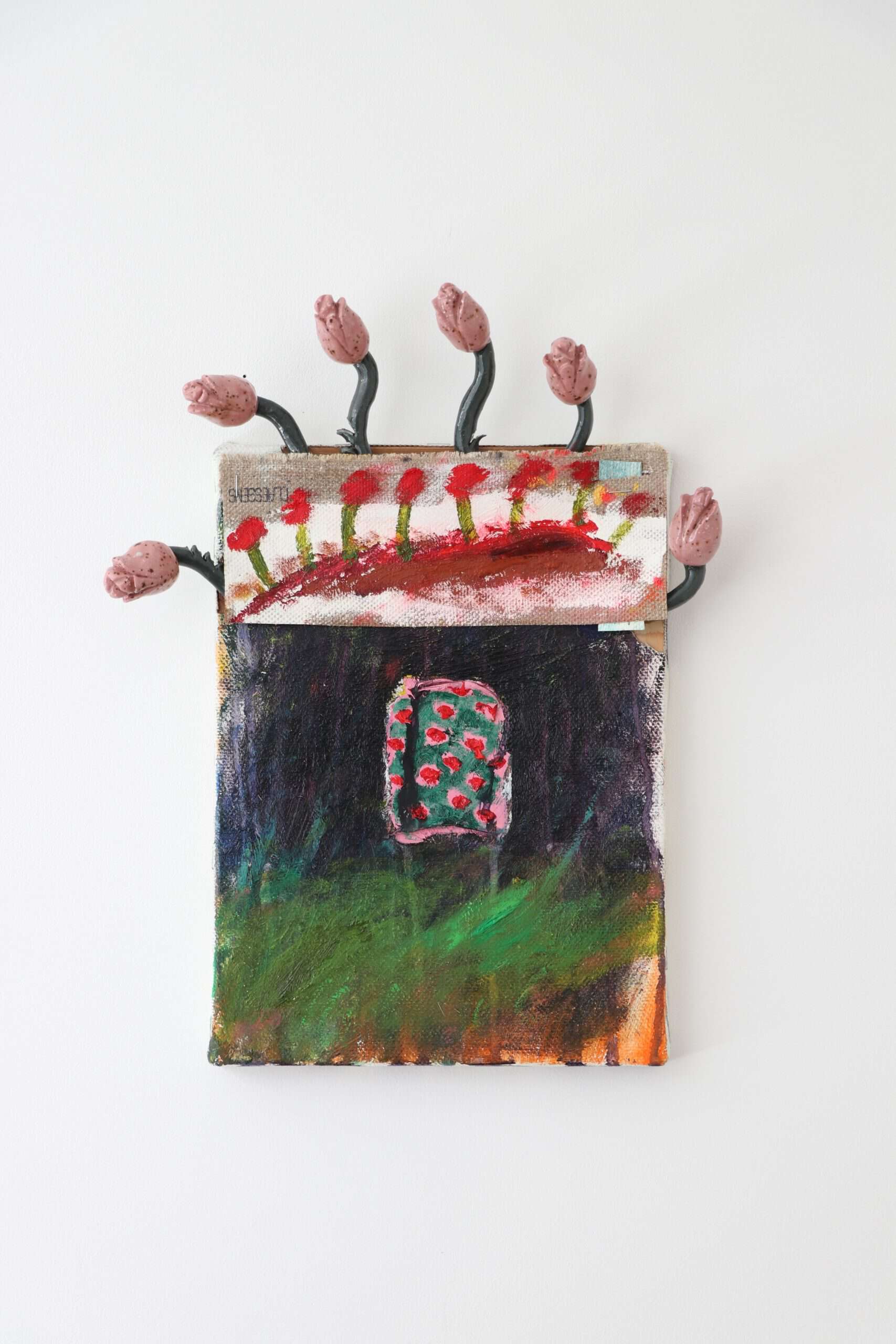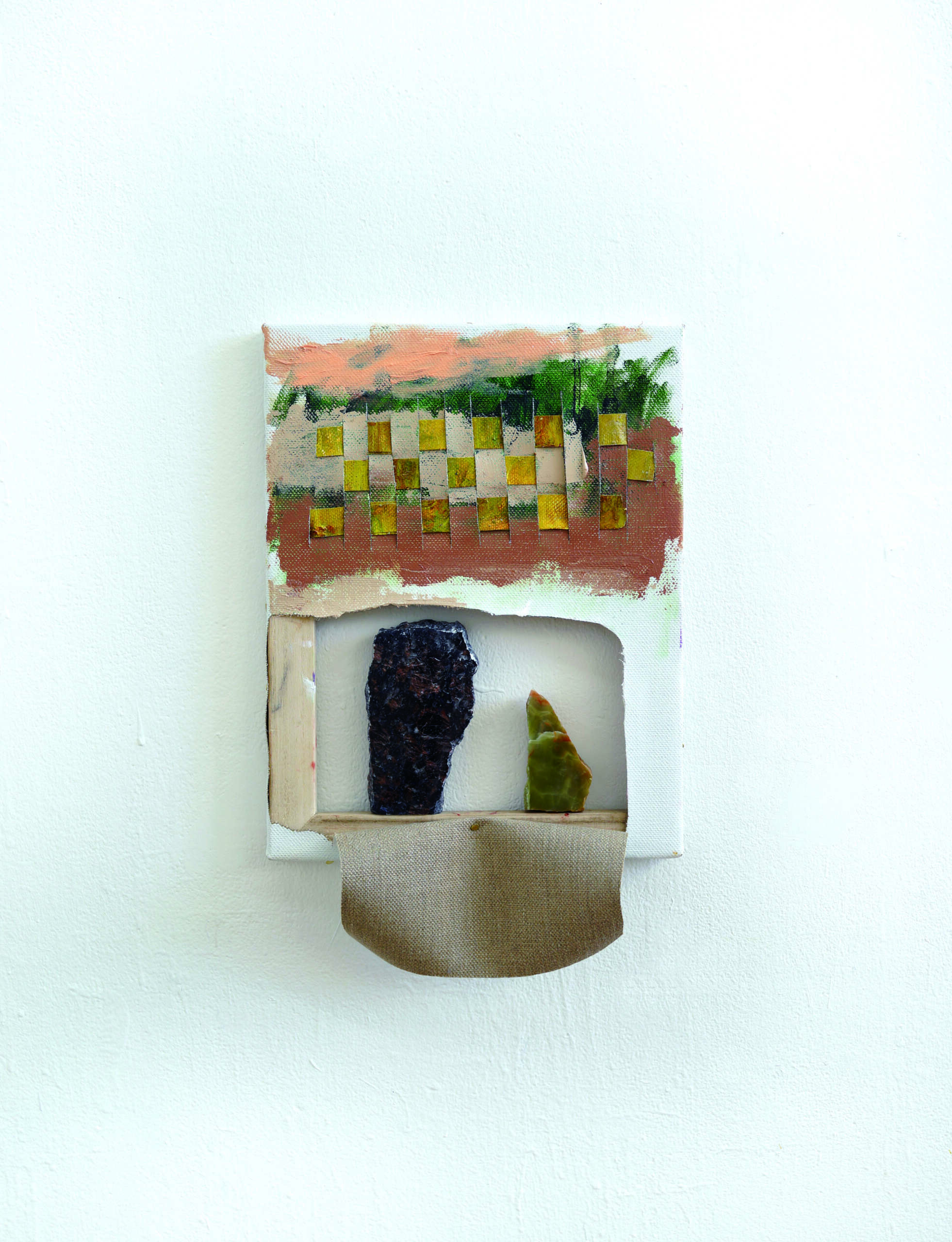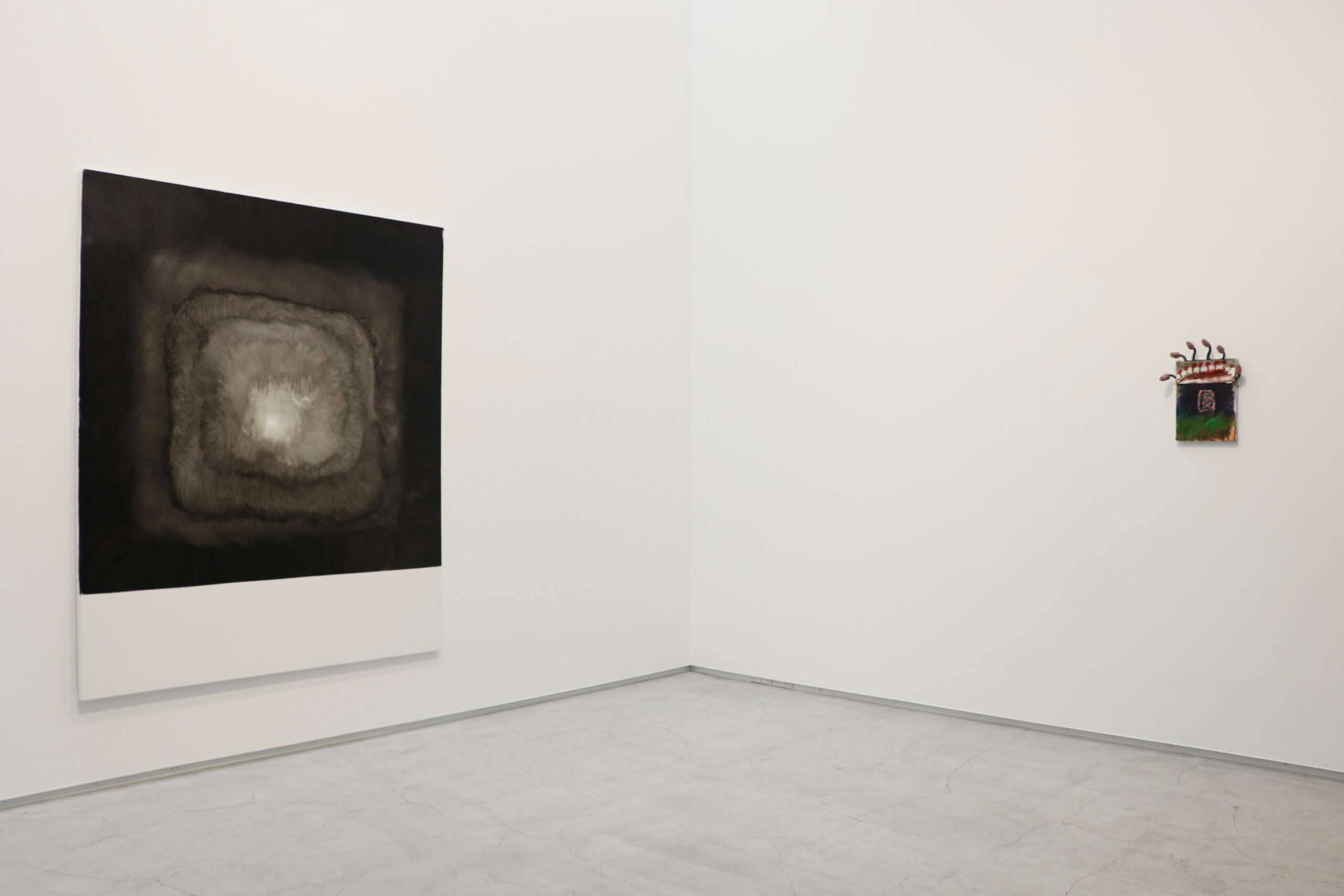I want to reach out to the other side, or rather, I want to look at the other side, while experiencing the many layers of the position of the painter, the position of the canvas, and the position of the other side. Narumi Sasaki is a painter who cuts open a canvas and arranges stained glass, minerals, and other materials in a collage-like manner on the screen. She says that her world of painting, which is layered with multiple materials, is similar to "digging through a canvas. On the occasion of her first solo exhibition after graduating from the graduate school at LOKO GALLERY in Daikanyama, we had a chance to talk to her.

Tulip, Night Oil on Canvas/Ceramics, 42× 33cm, 2018 First of all, could you give us a brief description of your exhibition and your works? -In terms of composition, I mainly selected works from the past year and a half of my career. I graduated from university about a year and a half ago, and this was my first solo exhibition since then. As for my works, people often ask me if they are sculptures, three-dimensional works, or paintings, but in my mind, they are paintings, and I am presenting them as such. I've been painting for a long time now, and there was a period of time when I carefully explored within myself what painting is again, and I wasn't very conscious of it, but this time I have the impression that it has come out as a work or an exhibition.

Woven Grass Oil on Canvas/Stone, 50 × 32.5cm, 2018 Are you talking about the act of painting itself? Also, I think the collage element is prominent in your work, is this also a result of that? Well... it was around 2017 that I made a definite shift towards cutting the canvas and putting things together like a collage. At that time, I was actually studying abroad in France for about half a year, and that was a pretty big starting point. I went there to study modern art, and among other things, I became very interested in religious facilities. Over there, there are Christian churches, Islamic temples, Jewish temples, and facilities that are a mixture of various situations. I was interested in looking at decorative arts in such places, but as I went to several of them, I became fascinated by the fact that the spiritual structure that people seek or have to seek in order to live, and the products that go along with it, are all the same. I was absorbed in this. I can't really put it into words yet, but I think drawing may be close to that kind of desire. However, I really felt that I had to wait for something different, something bigger than myself, to work in order to achieve that desire. I think that's how my work changed. So you started cutting canvases and such as a result of that? -Yes, it did. I haven't been able to put into words the specific cause-and-effect relationship, but at first I started by putting things together, and then I started to fill the canvas with various materials as a kind of decoration. There seems to be a variation in the materials, but at the same time there seems to be a common thread. Yes, I choose materials that are close to nature, to a point. Wood, ceramics, and also glass, stained glass. It's not always a good idea, and sometimes I don't think it's a good idea at all, but I'm waiting for the right combination. It wasn't until then that I started cutting canvas. Is that a way of dealing with the mixture of the two? -I can't wait when I'm painting. There are times when I am painting in a saturated state where there is nothing I can do. And when I want to somehow turn it upside down... or rather, when I have the desire to turn it upside down, I cut the canvas. But when I cut it, I'm really surprised, even by myself. Even though I cut it myself (laughs). (laughs) "Oh, I cut it. But still, when I cut it, I felt strong, or like I couldn't go back. It's like the whole world has changed at once, like a natural disaster has happened. It's as if the world has changed in one fell swoop. It doesn't mean that there will be no change, but rather... something that had a certain form will break down, and while the current situation will be restored, different elements will be incorporated, and this will activate the recombination in the picture. However, the painting that emerges as I manage to cope with this cataclysmic situation is, of course, what I am looking for, but it is also more beautiful than I am looking for. I feel that this situation itself is very similar to the world itself. There are many different scales of the world, and in a very large sense, I think it is similar to the structure of the universe, but I also think that there is a world in the interpersonal relationships that we are talking about right now. I would like to understand this relationship and the way it is when I paint.

Returning to the collage, do you consciously create this kind of multilayered effect? -I don't consciously think about it while I'm working, but it's true that my works are often very layered, and when I look at the result, I often think, "Oh, that's important. When I look at the canvas before painting, it looks like a white wall. It looks like a curtain, or a curtain that is hiding something. What I am looking for when I paint, I think that there is something behind the canvas. ...I sometimes touch the canvas when I paint. It's white and there's nothing there, but I feel that there is something behind it, and that it might lead to something. I want to get to the back of it, but the wall of canvas is so thick. I keep trying to get there, but the structure of depth is very important in that case. I want to reach out to the other side, or rather, I want to see the other side, while experiencing the many layers of the painter, the canvas, and the other side. So it's almost like I'm digging a little bit. I want to break through this canvas material and reach the other side, so as a result, it has to be multi-layered in some ways. Is it important to choose materials that are close to nature when digging or layering? -There's a simple affinity with the material, but I'm really interested in stones and soil. ...I know it's a very abstract way of putting it, but I'm really interested in the inexorable feeling of stone and soil, or the fact that although they are inexorable, stones seem to remain unchanged over time, but when you polish them, they change their shape. Whether it is stone or wood, I feel that each has its own hidden power, and it is easy to expand one's imagination. As for glass, I started using it when I was visiting churches. Stained glass is set up on the wall like a canvas, standing against the sky, and the light coming from behind the stained glass illuminates the colors and brings them to us. I thought that there was a mechanism that made me feel an indescribable emotion. I also heard from the muralist that cutting the stained glass is a part of the sisters' training, and I was curious about the origins of cutting and pasting while holding some kind of spirituality. It's a special material for me because of its function and also because I feel that the background itself has a meaning. For example, "Flexible Cosmos" is somewhat like a landscape painting, but is it possible to envision the "other side of the canvas" that you said you wanted to reach? -To be honest, I haven't been able to express it well in my own words yet. I want to touch it, but I don't know what it is, and I can't say it clearly in my own words, and for convenience, the gallery described it as "metaphysical," but it still doesn't feel right to me. The title of the exhibition is ".../ # La la la la la la la la la la la .......... Do do do do do do... Ah ah ah... I'm thinking that if you look at it from the side, it looks like a rice field, the horizon, and the moon (laughs). There is a rice field behind my studio, and I often go for a walk when I am stuck, and it is a very large field, and there are no tall buildings, so I can see the sky clearly, and I can see the sky and horizon line on the other side, and the moon is above it. I thought that this was similar to the feeling of painting a picture on this side of the canvas while facing the other side. I think that the world view, the sense of landscape, the rice field, the horizon, and the moon, is similar to the structure of a painting. I'd like to deepen my thoughts on what this can indicate in the future. That's it for this interview. Thank you very much for your time today. -Thank you very much for your time.

Narumi SASAKI Born in Hiroshima Prefecture in 1990. Graduated from Tokyo National University of Fine Arts and Music in 2014 with a degree in oil painting. Studied at the University of the Arts Nantes (France) in 2016, and completed her postgraduate studies in oil painting at the Tokyo University of the Arts in 2018. Major solo exhibitions: "wonder world: Narumi Sasaki Solo Exhibition", Tokyo Wonder Site Shibuya, 2014; "Narumi Sasaki Solo Exhibition", Tokyo Metropolitan Government Office, 2014. Major group exhibitions: 2018 "Art Award Marunouchi 2018", Marunouchi Gyoko Underground Gallery, 2018. "Geidai Underground" / Echika Ikebukuro Gallery. 2014 "Higashi Omiya Young Artist" / Higashi Omiya Community Center. Center. 2014 "Masato Kobayashi and Daisuke Oba Laboratory Exchange Exhibition" / Kyoto University of Art and Design, 2013. Major Awards: Art Award Marunouchi, 2018; Akiya Takahashi Prize, 2018; Metro Cultural Foundation Prize, 2018; Tokyo Wonder Wall Prize, 2013; Ueno Geiyu Prize, 2013. Major Scholarships: Kamiyama Foundation Art Program, 2017. Hiroshima Scholarship, 2017. Jasso Student Exchange Support Organization, 2017. Narumi Sasaki / # La la la la la la la la la la la .......... Do do do do do... Ah ah ah... Period: October 4 - November 2, 2019 Venue: 12-6 Uguisudani-cho, Shibuya-ku, Tokyo LOKO GALLERY Opening hours: 11:00 - 19:00 Closed on Sunday, Monday and Holidays Access: 6 minutes walk from Daikanyama Station (Tokyu Toyoko Line) URL http://lokogallery.com/